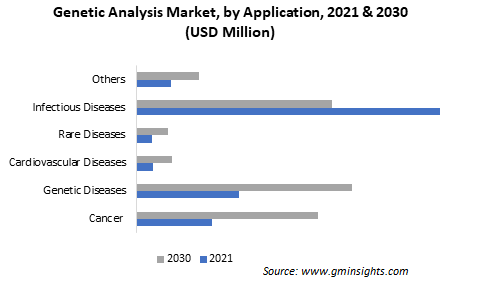Home > Healthcare > Biotechnology > Biotechnology R&D > Genetic Analysis Market
Genetic Analysis Market Analysis
- Report ID: GMI5379
- Published Date: Oct 2022
- Report Format: PDF
Genetic Analysis Market Analysis
Genetic analysis market from the carrier testing segment will register over 7.5% CAGR from 2022-2030. Carrier testing determines if a healthy person carries a recessive genetic disorder. The test offers life-long insights into the reproductive risk of an individual and the chances of having offspring with a genetic disorder. Advancements in carrier testing enable the identification of at-risk couples and carriers of disease genes. With the growing awareness about genetic disorders, the demand for genetic carrier testing for reproductive risk assessment will witness a steady increase.

Genetic analysis market from the infectious diseases segment is anticipated to reach USD 3 billion by 2030. Infectious diseases such as COVID-19 have varying impacts on different genomes. According to the UK Research and Innovation, men are more likely to be infected with COVID-19 than women due to the presence of only one X chromosome. There is a surging need for analysis of similar tests to address many other infection risks. The increasing burden of diseases will thus create high demand for urgent diagnosis and treatment tools, including genetic analysis.

Genetic analysis market value from the next-generation sequencing (NGS) technology is expected to depict over 8.5% CAGR between 2022-2030. Cancer has affected a significant amount of people across the world. As per the Cancer Atlas, the cancer burden is predicted to increase by more than 60% by 2040. NGS technology allows doctors to test multiple cancer-related genes simultaneously.
After the surgical removal of a patient’s tumor, the tumor tissues can be used for next-generation sequencing. In some cases, it is possible to study the blood sample of the patient to check if the disease has shed some tumor DNA in the bloodstream. Advantages such as this showcase the strong potential of NGS technology in genetic analysis of cancer patients.

Diagnostic centers segment will hold over 21.5% share of the global genetic analysis market by 2030. Early disease diagnosis enables patients to go through treatment at an earlier stage and mitigate disease severity which will reduce the mortality rate. In addition, the rising prevalence of acute disorders is amplifying the need for dedicated diagnostics centers with genetic testing facilities. These factors, along with global awareness regarding the importance of early disease diagnosis will generate lucrative growth opportunities for segment development.

Europe genetic analysis market is set to cross USD 3 billion by 2030. Growing R&D initiatives to advance genomic analysis has resulted in breakthrough discoveries in Europe. A notable example is research in genomics conducted by Swedish geneticist Svante Pääbo, which identified that gene transfer took place from now-extinct hominins to Homo Sapiens, after migrating from Africa close to 70,000 years ago. This gene flow also influences the physiology of the modern human population and is considered helpful in identifying measures to cure or avoid acute disorders. Such pathbreaking research projects are expected to create a favorable outlook for the genetic analysis industry in Europe.

